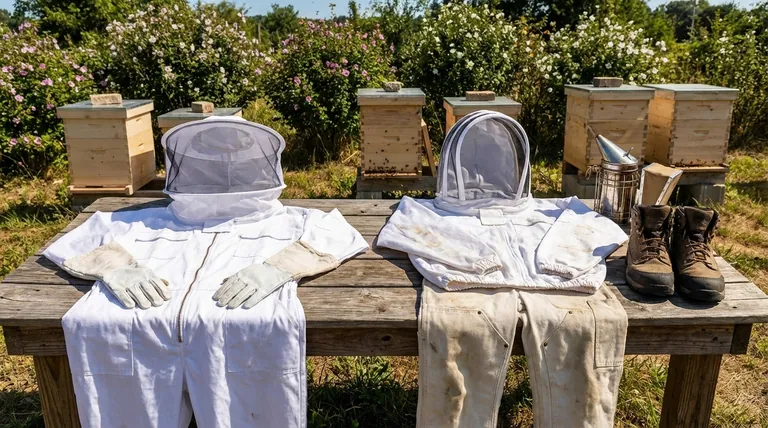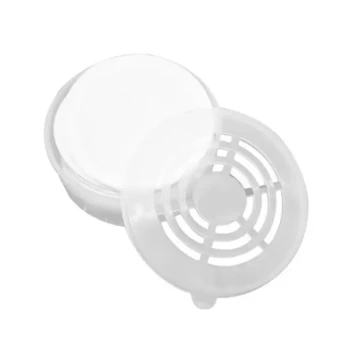The fundamental difference between a full beekeeping suit and a jacket with a veil lies in the extent of coverage. A full suit is a single garment providing head-to-toe protection, completely enclosing your body. A jacket and veil system protects only your upper body and head, requiring you to separately protect your legs and feet.
The choice between a full suit and a jacket is not about which is "better," but about balancing your personal need for security against the practical demands of convenience and comfort in your specific beekeeping environment.

The Anatomy of Protection: Suit vs. Jacket
Choosing your primary protective gear is one of the first major decisions a beekeeper makes. Understanding the design of each option is the first step.
The Full Suit: An All-in-One Fortress
A full suit is a one-piece coverall, often with an integrated or attachable veil. It is designed to be a single, seamless barrier against bee stings.
This design offers the most complete and worry-free protection available. Because it covers your entire body, it eliminates gaps between your shirt and pants where a bee could potentially enter.
The Jacket and Veil: A Modular Approach
A jacket and veil combination protects your torso, arms, neck, and head. This leaves your lower body exposed, making it your responsibility to complete the protective outfit.
To be safe, a jacket must be paired with thick, sting-resistant pants like heavy denim or canvas painter's pants. You must also ensure there are no entry points for bees, typically by tucking your pants into sturdy, over-the-ankle boots.
Key Decision Factors
Your decision should be based on three critical factors: the level of protection you need, the convenience you desire, and the climate you work in.
Protection Level
The full suit offers the highest level of security. It is the preferred choice for professionals, beekeepers working with aggressive colonies, or anyone who wants maximum peace of mind.
A jacket system's protection is only as good as the pants and boots you pair it with. An oversight, like wearing thin pants or forgetting to tuck them into your socks, can lead to stings on the legs or ankles.
Convenience and Speed
For quick tasks like refilling a feeder or a brief hive check, a jacket is significantly faster and easier to put on and take off.
A full suit is a more involved garment to get into and out of, making it better suited for longer, more intensive apiary work sessions where you won't be changing in and out of your gear.
Heat and Comfort
Beekeeping is often done on warm, sunny days. A full suit can become extremely hot, as it traps body heat and limits airflow across your entire body.
A jacket is generally cooler. It allows for more natural air circulation around your legs, which can make a significant difference in comfort during hot weather.
Understanding the Trade-offs
Every piece of equipment has compromises. Being aware of them is key to making an informed choice and avoiding common mistakes.
The Full Suit's Compromise: Heat vs. Security
With a full suit, you are trading comfort for security. The price of near-total sting immunity is the potential for overheating, which can be a serious issue in warmer climates.
The Jacket's Responsibility: Diligence vs. Freedom
With a jacket, you are trading total protection for convenience. You gain freedom and comfort, but you accept the personal responsibility to always wear appropriate legwear and ensure there are no gaps for bees to exploit. Forgetting this step is a common beginner mistake.
Making the Right Choice for Your Apiary
Ultimately, your gear should serve your goals and comfort level. Use these guidelines to decide.
- If your primary focus is maximum safety and peace of mind: Choose the full suit, especially if you are a beginner or are known to have defensive bees.
- If your primary focus is convenience for quick tasks in a temperate climate: The jacket and veil system is a highly practical and comfortable choice, provided you have docile bees and are diligent about your legwear.
- If you are working in a very hot and humid environment: A well-ventilated jacket may offer a crucial comfort advantage over a full suit, making your beekeeping more enjoyable.
The right gear allows you to work with confidence, turning your focus from the fear of stings to the health of your bees.
Summary Table:
| Feature | Full Suit | Jacket & Veil |
|---|---|---|
| Coverage | Head-to-toe (full body) | Torso, arms, neck, and head only |
| Protection Level | Maximum security; ideal for pros/aggressive bees | High, but requires diligent leg/foot protection |
| Convenience | Slower to put on/off; best for long sessions | Quick and easy; ideal for brief hive checks |
| Heat & Comfort | Can be very warm; traps body heat | Cooler; better airflow for hot climates |
| Best For | Beginners, defensive colonies, maximum peace of mind | Experienced beekeepers, docile bees, warm environments |
Ready to Equip Your Apiary with Confidence?
Choosing the right protective gear is critical for the safety and productivity of your beekeeping operation. HONESTBEE is your trusted wholesale partner, supplying durable, high-quality beekeeping suits and jackets designed specifically for the demands of commercial apiaries and distributors.
We provide the reliable equipment that allows you to focus on your bees, not on your gear. Let us help you outfit your team with the best protection for any condition.
Contact HONESTBEE today to discuss your wholesale needs and get a quote!
Visual Guide

Related Products
- Wholesales Dadant Size Wooden Bee Hives for Beekeeping
- Professional Insulated Plastic Bee Hives
- Yellow Plastic Bucket Pail Perch for Beekeeping
- Long Langstroth Style Horizontal Top Bar Hive for Wholesale
- Automatic Honey Flow Beehive 4 Frame Mini Hive for Beekeeping
People Also Ask
- What types of products are available for beekeeping needs? Essential Equipment for Apiaries & Distributors
- Why were wooden hives traditionally preferred? For Natural Beekeeping Aligned with Bee Biology
- What should you do if you find an ant nest near your beehive? Essential Strategies for Hive Protection
- What is beekeeping equipment? Essential Tools for Commercial Apiaries & Distributors
- What should beginners consider when purchasing beekeeping equipment? A Guide to Essential Starter Gear



















